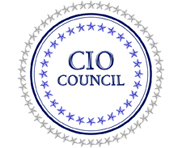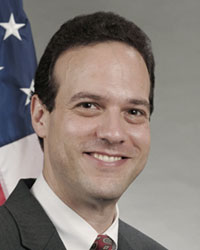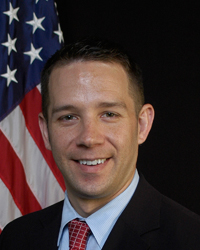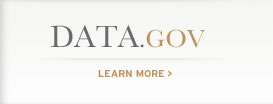Subscribe to RSS
An Official Website of the United States Government
NEWS
The Pulse of Federal IT
The Federal CIO Council and CIOs across the Federal government are communicating with the IT community and
the general public to report on real and measurable progress in IT Reform.
NEWS

Thursday, August 23, 2012
CIO Council 3-Month Deliverables under Digital Strategy
The CIO Council released two documents today as part of the 3-month deliverables under the Digital Government Strategy. Details about these two documents are listed below. For a full list of all products and deliverables released to date, please visit the Digital Government Strategy Deliverables page.
Bring-Your-Own-Device (BYOD) Toolkit (Milestone Action #3.3)
As part of its mission to promote cross-agency sharing of mobile workforce solutions, the Digital Services Advisory Group worked with the Federal CIO Council to develop a BYOD toolkit for agencies contemplating implementation of BYOD programs. By exploring options to increase the mobility of government workers, the Administration can save taxpayer dollars and improve its service to the American people. The toolkit includes key considerations, best practices, and examples of existing policies from successful BYOD programs launched at forward-leaning agencies.
Link: http://www.whitehouse.gov/digitalgov/bring-your-own-device (html) and http://www.cio.gov/byod-toolkit.pdf (pdf) Digital Services Governance Recommendations (Milestone Action #4.1)
As part of its mission to promote cross-agency sharing of best practices in the delivery of digital services, the Digital Services Advisory Group worked with the U.S. CIO Council and Federal Web Managers Council to develop recommendations on how agencies can stand up effective digital services governance structures consistent with Milestone Action #4.2. Recognizing that governance is a means to an end, the recommendations highlight opportunity areas for agencies to deliver better services at a lower cost.
Link: http://www.whitehouse.gov/digitalgov/digital-services-governance-recommendations (html) and http://www.cio.gov/digital-services-governance-recommendations.pdf (pdf)
Read Full Story ›
As part of its mission to promote cross-agency sharing of mobile workforce solutions, the Digital Services Advisory Group worked with the Federal CIO Council to develop a BYOD toolkit for agencies contemplating implementation of BYOD programs. By exploring options to increase the mobility of government workers, the Administration can save taxpayer dollars and improve its service to the American people. The toolkit includes key considerations, best practices, and examples of existing policies from successful BYOD programs launched at forward-leaning agencies.
Link: http://www.whitehouse.gov/digitalgov/bring-your-own-device (html) and http://www.cio.gov/byod-toolkit.pdf (pdf) Digital Services Governance Recommendations (Milestone Action #4.1)
As part of its mission to promote cross-agency sharing of best practices in the delivery of digital services, the Digital Services Advisory Group worked with the U.S. CIO Council and Federal Web Managers Council to develop recommendations on how agencies can stand up effective digital services governance structures consistent with Milestone Action #4.2. Recognizing that governance is a means to an end, the recommendations highlight opportunity areas for agencies to deliver better services at a lower cost.
Link: http://www.whitehouse.gov/digitalgov/digital-services-governance-recommendations (html) and http://www.cio.gov/digital-services-governance-recommendations.pdf (pdf)
Read Full Story ›

Thursday, July 12, 2012
Roadmap Toward IPv6 Adoption for the Federal Government
In September 2010, OMB issued a memorandum requiring federal agencies to transition to Internet Protocol Version 6 (IPv6) for public Internet servers and applications in use by the government. With deadlines for that transition coming in September 2012 and again in September 2014, the CIO Council is releasing an updated version of the "Planning Guide/Roadmap Toward IPv6 Adoption within the U.S. Government." (The Roadmap).
The Roadmap was jointly developed by the Federal Government and the American Council for Technology - Industry Advisory Council (ACT-IAC). The Roadmap will assist Federal agency leaders in this transition with practical and actionable industry and Federal agency best practice guidance on how to successfully integrate to the next generation Internet within their agencies.
The Roadmap has been updated from the original published in 2009 to provide the Federal Government's IPv6 history, vision, current goals, and deadlines. Based on the information provided in this document, agency Chief Information Officers, IPv6 Transition Managers, Chief Enterprise Architects, and Chief Acquisition Officers should assess their agency's progress towards IPv6 adoption. This includes critical assessment of their current transition plans.
Read Full Story ›
Read Full Story ›

Wednesday, May 23, 2012
Announcing the Digital Government Strategy
Today, the President issued a directive entitled “Building a 21st Century Digital Government”. It launches a comprehensive Digital Government Strategy – pdf and html5 versions aimed at delivering better digital services to the American people. The strategy complements several initiatives, including Executive Order 13571, Streamlining Service Delivery and Improving Customer Service, and Executive Order 13576, Delivering an Efficient, Effective, and Accountable Government.
The Federal Government must be able to deliver information and services to the American people anytime, anywhere and on any platform or device. For far too long, agencies delivered their information in programmatic silos, missing opportunities for coordination or collaborative partnerships. The Digital Government Strategy was developed to provide agencies with guidance on improving digital services and to enable the government to thrive within the fast-paced, ever-changing world of technology.
As part of the strategy’s 12-month roadmap, agencies will mobilize two of their priority customer-facing services and begin to make open data the default for government IT systems. Learn more about the strategy in Federal CIO Steven VanRoekel’s White House blog post.
Read Full Story ›
Read Full Story ›

Wednesday, May 02, 2012
OMB Launches Federal IT Shared Services Strategy
The Federal IT Shared Services Strategy was released by OMB today to provide Federal Agency Chief Information Officers and key stakeholders guidance on the implementation of shared IT services as a key part of their efforts to eliminate waste and duplication and reinvest in innovative mission systems. Federal CIO, Steven VanRoekel also issued a memorandum to agency CIOs laying out requirements for agencies that support the strategy.
This strategy is one of the actions identified in the December 2010 25-Point Implementation Plan to Reform Federal IT Management. The strategy covers the entire spectrum of IT shared service opportunities throughout the Federal Government and promotes the use of existing and new strategic sourcing methods where agencies can combine their buying power for similar IT needs and get lower prices and improved service leverage in the process. Accompanying this strategy is the Common Approach to Federal Enterprise Architecture, which provides agile, standardized methods and tools for designing the next generation of IT resources and shared services that agencies will need to successfully accomplish their missions in the face of tight resources and rising customer needs.
Referred to as “Shared-First”, the Federal IT Shared Services Strategy will improve the return on investment for IT spending, close productivity gaps, increase communications with the managing partners and customers of shared services, and support agencies in implementing their PortfolioStat process per M-12-10. Shared-First principles and the Common Approach to making agencies future-ready creates new opportunities for industry to provide shared IT services to agencies that are more agile in delivery and more responsive to a wide variety of evolving mission, support, and commodity IT requirements. The strategy recognizes the need for agencies to gain proficiency in managing or consuming shared IT services and therefore provides an initial focus on commodity IT consolidation opportunities, as called for in the August 2011 OMB memo (M-11-29) to Chief Information Officers.
Click here to access the Federal IT Shared Services Strategy
Click here to access the Common Approach to Federal Enterprise Architecture
Read Full Story ›
Click here to access the Common Approach to Federal Enterprise Architecture
Read Full Story ›
BLOGS

Tuesday, September 04, 2012
Robert Brese, CIO, Department of Energy
Robert Brese, CIO, Department of Energy
Transform, Protect and Advance – DOE’s IT Modernization Strategy
The Obama Administration’s Digital Government Strategy provides a vision for a 21st century government that lays a strong foundation for modernizing technology services across the Federal Government. At Energy, we’re implementing a three-pillar approach -- Transform, Protect and Advance – as part of this broader strategy, driving more secure, cost-effective, and efficient IT infrastructure and services.
Read Full Blog ›

Wednesday, August 29, 2012
Simon Szykman, CIO, Commerce
Simon Szykman, CIO, Commerce
Doing More with Less: Taxpayers Will Save with Commerce's New Adobe Contract
This campaign is an administration-wide effort to make government more transparent and accountable to the American people. As part of this ongoing initiative, the Commerce Department is looking for new ways to boost efficiencies and to be good stewards of taxpayer dollars. The Department’s fiscal year 2013 budget request identified a total of $176 million in savings through lower-cost acquisitions, reduced overhead expenses, and better management of facilities and vehicles.
Read Full Blog ›

Monday, August 27, 2012
Darren Ash, CIO and Deputy Executive Director for Corporate Management
Darren Ash, CIO and Deputy Executive Director for Corporate Management
Harnessing Technology to Make the NRC More Effective and Efficient
There was a time when Federal employees had better computer equipment in their offices than what they could purchase for themselves at a local consumer electronics store. While I can’t pinpoint what year that reality switched, it is now a firm truth that our staff can buy advanced computers, amazing smart phones and tablet computers for their own use while government agencies like the Nuclear Regulatory Commission (NRC) have generally lagged behind in what types of technology is being provided.
Read Full Blog ›

Thursday, August 23, 2012
Brook Colangelo, CIO, Executive Office of the President
Brook Colangelo, CIO, Executive Office of the President
Enabling a Mobile Workforce through Bring Your Own Device
As a core deliverable of the Digital Government Strategy, the Federal CIO Council and the Digital Services Advisory Group released the BYOD toolkit as a resource for agencies contemplating implementation of BYOD programs.
Read Full Blog ›
VIDEO

Tuesday, July 12, 2011
Open for Questions: Improving Federal Websites
White House Director of Digital Strategy Macon Phillips, Federal Chief Information Officer Vivek Kundra and Director of the GSA’s Center for Excellence in Digital Government Sheila Campbell discuss ways to improve the online experience with Federal websites and the campaign to reduce the number of excess and duplicative government websites.
View Video ›
View Video ›

Monday, July 11, 2011
Simon Szykman: What are you working on right now?
Simon Szykman, Chief Information Officer, Department of Commerce (DoC) describes the latest developments at his agency.
View Video ›
View Video ›

Wednesday, April 27, 2011
White House Forum on Transforming Federal Information Technology (IT) Management
Jeffrey Zients, U.S. Chief Performance Officer and OMB's Deputy Director for Management, and Vivek Kundra, U.S. Chief Information Officer, discuss progress made towards changing the way the Federal government uses IT to save money and deliver better service.
View Video ›
View Video ›

Thursday, April 21, 2011
FedMentors: Michael Carleton
Michael Carleton, Chief Information Officer, U.S. Dept. of Health and Human Services (HHS) answers:
View Video ›
View Video ›




